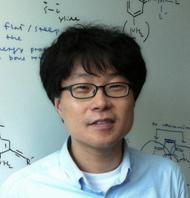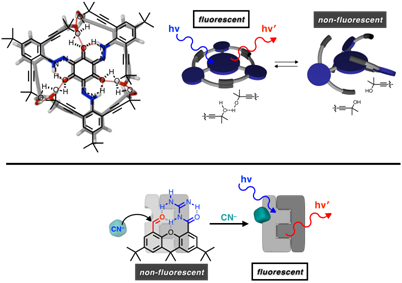










|
Title of Talk Stimuli-Responsive Electronic Conjugation
Abstract Taking inspiration from mechanically-triggered opening and closing motions of certain transmembrane protein channels, we have been developing a new class of non-rigid aromatic-rich molecules, in which multiple, π-conjugated structural subcomponents undergo correlated bond twisting motions in response to external stimuli. Our primary scientific objective in this research is establishing synthetic routes to a general structural platform that can correlate and amplify externally triggered bond rotations, and convert such mechanical input signals to readable optoelectronic output signals of molecular switches and chemical sensors. While studies on such molecular systems in solution should be an important first step to understand fundamental structure–property relationships, their ultimate incorporation into various device settings requires efficient assembly strategies to align individual molecules over large domains. Toward this objective, my group is taking both covalent and non-covalent synthetic approaches to bring multiple π-conjugated molecular components in close proximity to facilitate transport of optical excitations or charge carriers. In this presentation will be discussed the advent of this chemistry, our accomplishments, projected evolution, and potential applications.
References: 1. Jo, J.; Olasz, A.; Chen, C.-H.; Lee, D, J. Am. Chem. Soc. 2013, 135, 3620 2. Jo, J.; Lee, H. Y.; Liu, W.; Olasz, A.; Chen, C.-H.; Lee, D, J. Am. Chem. Soc. 2012, 134, 16000 3. Lee, H.; Song, X.; Park, H.; Baik, M.-H.; Lee, D, J. Am. Chem. Soc. 2010, 132, 12133 |
|
Dongwhan Lee, Associate Professor
Department of Chemistry, College of Natural Sciences, Seoul National University, Seoul 151-747, SOUTH KOREA e-mail: dongwhan@snu.ac.kr
Dongwhan Lee was born in Korea and undertook a major in chemistry at Seoul National University, receiving both B.S. and M.S. During his graduate research at Massachusetts Institute of Technology, he worked with Prof. Stephen J. Lippard on the bioinorganic modeling studies of dioxygen-activating non-heme diiron enzymes. In the fall of 2001, he was awarded a Ph.D. degree, and moved on to pursue postdoctoral research in the laboratory of Prof. Timothy M. Swager. As part of organic materials research there, he developed synthetic routes to conducting polymer sensors. In 2003, Lee began his independent career as Assistant Professor of Chemistry at Indiana University Bloomington, where he was promoted to Associate Professor with tenure in 2009. In Summer 2013, he moved his research group to the School of Chemistry at Seoul National University. His research program is broadly based on synthetic inorganic and organic chemistry of functional molecules and materials, with current focus on long-range mechanical coupling of artificial receptors, reaction-based chemical sensing, self-assembly and photophysics of discotic fluorophores, and conformational dynamics of shape-adaptive chemical architectures for molecular switching. He is the awardee of NSF Faculty Early Career Development (CAREER) Award (2006–2010) and Alfred P. Sloan Research Fellowship (2008–2010).
Selected Publications 1. Jo, J.; Olasz, A.; Chen, C.-H.; Lee, D, J. Am. Chem. Soc. 2013, 135, 3620 2. Jo, J.; Lee, H. Y.; Liu, W.; Olasz, A.; Chen, C.-H.; Lee, D, J. Am. Chem. Soc. 2012, 134, 16000 3. Lee, H.; Song, X.; Park, H.; Baik, M.-H.; Lee, D, J. Am. Chem. Soc. 2010, 132, 12133 4. Liu, W.; Huang, W.; Pink, M.; Lee, D, J. Am. Chem. Soc. 2010, 132, 11844 5. Jo, J.; Lee, D., J. Am. Chem. Soc. 2009, 131, 16283 |

